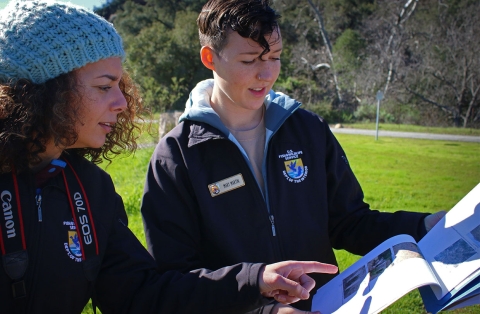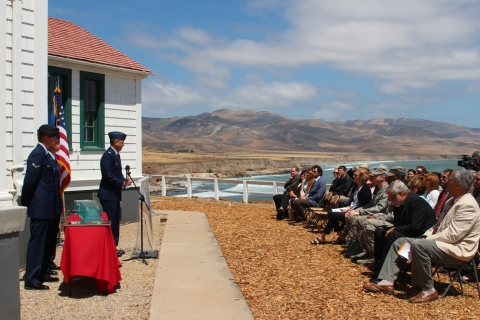Our Services
SECTION 7 CONSULTATIONS
Federal agencies are required to consult with the Service under Section 7 Section 7
Section 7 Consultation
The Endangered Species Act (ESA) directs all Federal agencies to work to conserve endangered and threatened species and to use their authorities to further the purposes of the Act. Section 7 of the Act, called "Interagency Cooperation," is the mechanism by which Federal agencies ensure the actions they take, including those they fund or authorize, do not jeopardize the existence of any listed species.
Learn more about Section 7 of the Endangered Species Act when federal projects may result in take of a listed species or damage critical habitat for a listed species. Each year, our staff completes hundreds of formal and informal consultations with other federal government agencies, keeping project timelines on-track, and wildlife and habitat protected.
CONTACTS:
Mark Elvin, Section 7 Program Coordinator, mark_elvin@fws.gov
Leilani Takano, Assistant Field Supervisor, North Coast Division, FW8VenturaSection7@fws.gov (Monterey County, Santa Cruz County, San Benito County)
Joseph Brandt, Assistant Field Supervisor, Central Coast Division, FW8VenturaSection7@fws.gov (Southern Monterey County, Santa Barbara County, San Luis Obispo County)
Chris Diel, Assistant Field Supervisor, South Coast Division, FW8VenturaSection7@fws.gov (Los Angeles County, Ventura County, Southern Santa Barbara County)
VOLUNTARY CONSERVATION PARTNERSHIPS
The Partners and Coastal Programs are not typical granting programs. Our biologists work closely with landowners and land managers to identify, develop, coordinate, and implement habitat restoration projects on a voluntary basis. We operate as a partner, not strictly a funding agency. We rely on landowners who want to restore their property and agree to maintain the restoration for at least ten years. In addition to forming partnerships with private landowners, we work with private organizations, and local, state, or other Federal government programs. The first step in becoming a partner is to contact us with ideas and questions.
Eligible landowners include private individuals, corporations, non-profit organizations, tribes, cities, counties, schools, and other state and federal agencies. We prioritize projects that benefit trust resources, including threatened and endangered fish, wildlife, and plants, migratory birds, and anadromous fish. Our team can provide cost-share funds and technical assistance to our partners. Highest priority projects are those that restore native habitat and provide long-term benefits to Federal trust species. These include anadromous fish, migratory birds, and rare or listed species. Examples of common project types include:
- Revegetation with native trees and shrubs
- Removing non-native vegetation
- Restoring ponds and other wetlands for native wildlife
- Livestock exclusion fencing and off-site watering
- Grassland restoration
- Improving fish passages and in-stream conditions for fish
- Restoring hydrology of streams and estuaries
- Supporting applied assessment, research and monitoring efforts focused on filling critical data gaps
- Supporting focused education/outreach efforts
HOW TO GET INVOLVED
Step 1: Contact us.Projects are developed year round. To initiate the application process, contact a Partners Program or Coastal Program biologist. The biologist can discuss project ideas, answer questions, and schedule a site visit to eligible projects
Colleen Grant, Senior Coastal Program Biologist, Colleen_Grant@fws.gov
Michael Glenn, Partners for Fish and Wildlife Biologist, Michael_Glenn@fws.gov
Step 2: Arrange for a site visit. The landowner and/or applicant and Partners/Coastal biologist meet on the property to evaluate restoration potential and discuss project objectives. The biologist helps to determine habitat improvements that can be made on the property, including advice on design, techniques, work plan, and budget.
Step 3: Project Selection. Funding decisions will generally be made by March. Inquire with the Partners/Coastal biologist in your area for the current status of funding decisions.
Step 4: Develop a project work plan. If a project is selected for funding, our biologists will work with you to develop a detailed project work plan, as needed.
Partners for Fish and Wildlife Program | Coastal Program | |
|---|---|---|
| Eligible Landowners |
| • Private parties • Corporations • Non-profit organizations • Tribes • Cities • Counties • Schools • State and Federal entities |
| Cost-share | Applicant must match Federal share. (The match can be in the form in-kind goods and services.) | Applicant encouraged to match Federal share. (The match can be in the form in-kind goods and services.) |
| Funding amounts | From less than $1,000 to $25,000. Most awards are $5,000 to $18,000. We also provide technical assistance on project development. | No monetary cap but resources are prioritized based on the needs of federal trust resources. We also provide technical assistance on project development |
| When to apply | Projects are developed year round. Funding decisions will generally be made by March | Projects are developed year round. Funding decisions will generally be made by March |
CONSERVATION BANKS
Conservation banks are large pieces of land that are permanently protected and managed for endangered, threatened or at-risk species. Conservation banks function to offset adverse impacts to listed and at-risk species that occurred elsewhere. This is better known as off-site mitigation.
A conservation bank is like a financial bank. It protects these resources like a bank protects your money. When someone plans a project that will impact endangered species or other natural resources, they can buy credits in a conservation bank. The bank owner then uses the money to protect the resources in the bank. Traditionally, project developers have been asked to preserve part of the area they are developing. Sometimes this is a good policy. But lots of times it is better to have larger areas protected in conservation banks. It is also more efficient and cost effective to manage a bank instead of small, isolated properties. The Ventura Fish and Wildlife Office has approved multiple conservation banks in California resulting in the conservation of thousands of acres of lands for species mitigation. We work closely with conservation bank owners to ensure the habitat is permanently conserved and managed. When a conservation bank is approved, the Service authorizes a specified number of habitat or species “credits” that bank owners may sell to developers or other project proponents to mitigate for the impacts resulting from their projects. Bank owners contribute a portion of the sale to an endowment that provides money for the management and protection of the bank property in perpetuity.For more information, contact Conservation Banking Coordinator Jeff Phillips at jeff_phillips@fws.gov.
Conservation Banks within Our Service Area
Sparling Ranch Conservation Bank
La Purisima Conservation Bank
Zayante Sand Hills Conservation Bank
Palo Prieto Conservation Bank
ENVIRONMENTAL CONTAMINANTS
The U.S. Fish and Wildlife Service works with state and federal trustee agencies, in coordination with local cities, counties, and other organizations, to assess impacts from oil spills and other environmental hazards on natural resources. Through this process, known as a Natural Resource Damage Assessment, trustees aim to quantify the injuries to wildlife, habitat, and lost use of those resources, and to develop a restoration plan and to secure compensation for resources lost or degraded by hazardous waste releases or spills. For more information, contact Natural Resource Damage Assessment and Restoration Coordinator Colleen Grant at colleen_grant@fws.gov.
WORKING WITH THE MILITARY
The U.S. Fish and Wildlife Service works in coordination with military installations to manage natural resources on military lands under the Sikes Act.
All military installations with significant natural resources are required to develop and implement integrated natural resources management plans (INRMPs) in cooperation with the U.S. Fish and Wildlife Service and the appropriate state wildlife agency. We work with several military installations in California, including Vandenburg Space Force Base and Navy Base Ventura County. As partners, we work together to maximize on-site conservation efforts and provide guidance related to habitat management and species protection. Projects on military bases range from dismantling dams that have lost their purpose to guiding the development of new infrastructure to building pollinator gardens. Military bases have been great conservation partners, implementing projects that support the recovery of listed and at-risk species.






